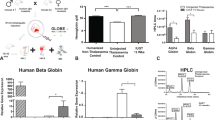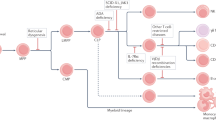Abstract
Inefficient gene transfer, inaccessibility of stem cell compartments, transient gene expression, and adverse immune and inflammatory reactions to vector and transgenic protein are major barriers to successful in vivo application of gene therapy for most genetic diseases. Prenatal gene therapy with integrating vectors may overcome these problems and prevent early irreparable organ damage. To this end, high-dose attenuated VSV-G pseudotyped equine infectious anaemia virus (EIAV) encoding β-galactosidase under the CMV promoter was injected into the fetal circulation of immuno-competent MF1 mice. We saw prolonged, extensive gene expression in the liver, heart, brain and muscle, and to a lesser extent in the kidney and lung of postnatal mice. Progressive clustered hepatocyte staining suggests clonal expansion of cells stably transduced. We thus provide proof of principle for efficient gene delivery and persistent transgene expression after prenatal application of the EIAV vector and its potential for permanent correction of genetic diseases.
This is a preview of subscription content, access via your institution
Access options
Subscribe to this journal
Receive 12 print issues and online access
$259.00 per year
only $21.58 per issue
Buy this article
- Purchase on Springer Link
- Instant access to full article PDF
Prices may be subject to local taxes which are calculated during checkout


Similar content being viewed by others
References
Coutelle C, Douar AM, Colledge WH, Froster U . The challenge of fetal gene therapy. Nat Med 1995; 1: 864–866.
Douar AM et al. Foetal gene delivery in mice by intra-amniotic administration of retroviral producer cells and adenovirus. Gene Therapy 1997; 4: 883–890.
Lipshutz GS, Flebbe-Rehwaldt L, Gaensler KM . Reexpression following readministration of an adenoviral vector in adult mice after initial in utero adenoviral administration. Mol Ther 2000; 2: 374–380.
Vincent MC et al. Adenovirus-mediated gene transfer to the respiratory tract of fetal sheep in utero. Hum Gene Ther 1995; 6: 1019–1028.
Holzinger A et al. Intraamniotic administration of an adenoviral vector for gene transfer to fetal sheep and mouse tissues. Pediatr Res 1995; 38: 844–850.
Lipshutz GS, Flebbe-Rehwaldt L, Gaensler KM . Adenovirus-mediated gene transfer to the peritoneum and hepatic parenchyma of fetal mice in utero. Surgery 1999; 126: 171–177.
Lipshutz GS et al. Short-term correction of factor VIII deficiency in a murine model of hemophilia A after delivery of adenovirus murine factor VIII in utero. Proc Natl Acad Sci USA 1999; 96: 13324–13329.
Lipshutz GS, Flebbe-Rehwaldt L, Gaensler KM . Adenovirus-mediated gene transfer in the midgestation fetal mouse. J Surg Res 1999; 84: 150–156.
Themis M et al. Enhanced in vitro and in vivo gene delivery using cationic agent complexed retrovirus vectors. Gene Therapy 1998; 5: 1180–1186.
Senoo M et al. Adenovirus-mediated in utero gene transfer in mice and guinea pigs: tissue distribution of recombinant adenovirus determined by quantitative TaqMan-polymerase chain reaction assay. Mol Genet Metab 2000; 69: 269–276.
Porada CD et al. In utero gene therapy: transfer and long-term expression of the bacterial neo(r) gene in sheep after direct injection of retroviral vectors into preimmune fetuses. Hum Gene Ther 1998; 9: 1571–1585.
Hatzoglou M, Moorman A, Lamers W . Persistent expression of genes transferred in the fetal rat liver via retroviruses. Somat Cell Mol Genet 1995; 21: 265–278.
Tran ND et al. Induction of stable prenatal tolerance to beta-galactosidase by in utero gene transfer into preimmune sheep fetuses. Blood 2001; 97: 3417–3423.
Pitt BR et al. Retrovirus-mediated gene transfer in lungs of living fetal sheep. Gene Therapy 1995; 2: 344–350.
Yang EY et al. Fetal gene therapy: efficacy, toxicity, and immunologic effects of early gestation recombinant adenovirus. J Pediatr Surg 1999; 34: 235–241.
Schneider H et al. Sustained delivery of therapeutic concentrations of human clotting factor IX – a comparison of adenoviral and AAV vectors administered in utero. J Gene Med 2002; 4: 46–53.
Walter J et al. Successful expression of human factor IX following repeat administration of adenoviral vector in mice. Proc Natl Acad Sci USA 1996; 93: 3056–3061.
Naldini L et al. In vivo gene delivery and stable transduction of nondividing cells by a lentiviral vector. Science 1996; 272: 263–267.
Barry SC et al. Lentivirus vectors encoding both central polypurine tract and posttranscriptional regulatory element provide enhanced transduction and transgene expression. Hum Gene Ther 2001; 12: 1103–1108.
Park F, Kay MA . Modified HIV-1 based lentiviral vectors have an effect on viral transduction efficiency and gene expression in vitro and in vivo. Mol Ther 2001; 4: 164–173.
Tsui LV et al. Production of human clotting Factor IX without toxicity in mice after vascular delivery of a lentiviral vector. Nat Biotechnol 2002; 20: 53–57.
Olsen JC . Gene transfer vectors derived from equine infectious anemia virus. Gene Therapy 1998; 5: 1481–1487.
Andreadis S, Fuller AO, Palsson BO . Cell cycle dependence of retroviral transduction: an issue of overlapping time scales. Biotechnol Bioeng 1998; 58: 272–281.
Loser P, Jennings GS, Strauss M, Sandig V . Reactivation of the previously silenced cytomegalovirus major immediate-early promoter in the mouse liver: involvement of NFkappaB. J Virol 1998; 72: 180–190.
Rohdewohld H et al. Retrovirus integration and chromatin structure: Moloney murine leukemia proviral integration sites map near DNase I-hypersensitive sites. J Virol 1987; 61: 336–343.
Schachtner S, Buck C, Bergelson J, Baldwin H . Temporally regulated expression patterns following in utero adenovirus-mediated gene transfer. Gene Therapy 1999; 6: 1249–1257.
Martin-Rendon E et al. New methods to titrate EIAV-based lentiviral vectors. Mol Ther 2002; 5: 566–570.
Themis M et al. Successful expression of beta-galactosidase and factor IX transgenes in fetal and neonatal sheep after ultrasound-guided percutaneous adenovirus vector administration into the umbilical vein. Gene Ther 1999; 6: 1239–1248.
Woo YJ et al. In utero cardiac gene transfer via intraplacental delivery of recombinant adenovirus. Circulation 1997; 96: 3561–3569.
MacKenzie T et al. Efficient transduction of liver and muscle after in utero injection of lentiviral vectors with different pseudotypes. Mol Ther 2002; 6: 349.
Kafri T et al. Sustained expression of genes delivered directly into liver and muscle by lentiviral vectors. Nat Genet 1997; 17: 314–317.
Blomer U et al. Highly efficient and sustained gene transfer in adult neurons with a lentivirus vector. J Virol 1997; 71: 6641–6649.
Tarantal AF et al. Rhesus monkey model for fetal gene transfer: studies with retroviral-based vector systems. Mol Ther 2001; 3: 128–138.
Jordan A, Defechereux P, Verdin E . The site of HIV-1 integration in the human genome determines basal transcriptional activity and response to Tat transactivation. EMBO J 2001; 20: 1726–1738.
DePolo NJ et al. VSV-G pseudotyped lentiviral vector particles produced in human cells are inactivated by human serum. Mol Ther 2000; 2: 218–222.
Park F et al. Efficient lentiviral transduction of liver requires cell cycling in vivo. Nat Genet 2000; 24: 49–52.
Mitrophanous K et al. Stable gene transfer to the nervous system using a non-primate lentiviral vector. Gene Therapy 1999; 6: 1808–1818.
Stetor SR et al. Characterization of (+) strand initiation and termination sequences located at the center of the equine infectious anemia virus genome. Biochemistry 1999; 38: 3656–3667.
Donello JE, Loeb JE, Hope TJ . Woodchuck hepatitis virus contains a tripartite posttranscriptional regulatory element. J Virol 1998; 72: 5085–5092.
Ikeda Y et al. Gene transduction efficiency in cells of different species by HIV and EIAV vectors. Gene Therapy 2002; 9: 932–938.
Albrecht TR, Lund LH, Garcia-Blanco MA . Canine cyclin T1 rescues equine infectious anemia virus tat trans-activation in human cells. Virology 2000; 268: 7–11.
Hines R, Maury W . DH82 cells: a macrophage cell line for the replication and study of equine infectious anemia virus. J Virol Methods 2001; 95: 47–56.
Rohll JB et al. Design, production, safety, evaluation, and clinical applications of nonprimate lentiviral vectors. Methods Enzymol 2002; 346: 466–500.
Suzuki A et al. Flow-cytometric separation and enrichment of hepatic progenitor cells in the developing mouse liver. Hepatology 2000; 32: 1230–1239.
Acknowledgements
This work was sponsored by an MRC-programme Grant. S. Wadlington is funded by the Katherine Dormand Haemophilia Trust.
Author information
Authors and Affiliations
Rights and permissions
About this article
Cite this article
Waddington, S., Mitrophanous, K., Ellard, F. et al. Long-term transgene expression by administration of a lentivirus-based vector to the fetal circulation of immuno-competent mice. Gene Ther 10, 1234–1240 (2003). https://doi.org/10.1038/sj.gt.3301991
Received:
Accepted:
Published:
Issue Date:
DOI: https://doi.org/10.1038/sj.gt.3301991
Keywords
This article is cited by
-
Activation of homology-directed DNA repair plays key role in CRISPR-mediated genome correction
Gene Therapy (2023)
-
In vivo bioimaging with tissue-specific transcription factor activated luciferase reporters
Scientific Reports (2015)
-
Transduction of Fetal Mice With a Feline Lentiviral Vector Induces Liver Tumors Which Exhibit an E2F Activation Signature
Molecular Therapy (2014)
-
The Fetal Mouse Is a Sensitive Genotoxicity Model That Exposes Lentiviral-associated Mutagenesis Resulting in Liver Oncogenesis
Molecular Therapy (2013)
-
Efficient Gene Transfer Into the Mouse Lung by Fetal Intratracheal Injection of rAAV2/6.2
Molecular Therapy (2010)



